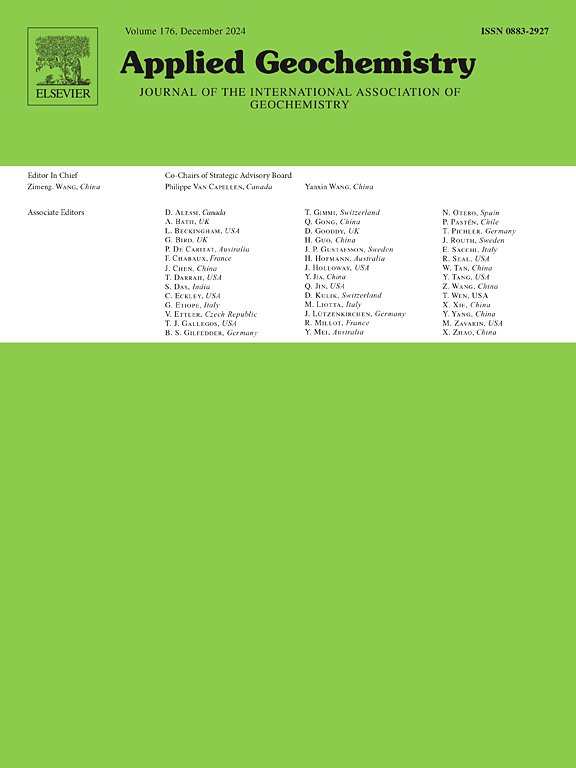Hindering the applicability of the authigenic 10Be/9Be dating by redeposition of mud in hybrid event beds, eastern Danube Basin, Slovakia
IF 3.1
3区 地球科学
Q1 GEOCHEMISTRY & GEOPHYSICS
引用次数: 0
Abstract
The authigenic 10Be/9Be dating method is a relatively new geochronological technique that shows great potential for use in epicontinental sedimentary successions, largely due to its ability to date ubiquitous mud. However, the factors influencing the applicability of this method are not yet fully understood, which limits its robust application. This study presents the first direct evidence that deep-water mud redeposition can lead to significantly older authigenic 10Be/9Be ages, with an offset of ca. 2 Myr in the studied example. The redeposition generated hybrid event beds (products of mixed gravity flows) on the Late Miocene basin floor of Lake Pannon. The source material for redeposition was the Middle Miocene successions exposed on the lake bottom, as indicated by reworked foraminiferal and calcareous nannoplankton fossils, as well as inorganic and organic geochemical proxies. This case study suggests that a thorough understanding of depositional processes and paleogeographic settings is essential when proposing future authigenic 10Be/9Be dating sampling strategies, to avoid the influence of deep-water mud redeposition by hybrid event beds. Additionally, a notable shift in geochemical signature was observed between syn- and post-rift phases. During the ca. 6 Myr-long rifting, sediment recycling and local provenance were dominant from the rifted basin margins, while the post-rift stage marked the onset of a regional-scale sediment routing system. Notably, organic matter preserved its compositional signature of the redeposited successions.

斯洛伐克多瑙河盆地东部混合事件层泥质再沉积对自生10Be/9Be定年的影响
自生10Be/9Be定年法是一种相对较新的地质年代学技术,在陆表沉积序列中显示出巨大的应用潜力,主要是因为它能够测定无处不在的泥浆的年代。然而,影响该方法适用性的因素尚未完全了解,这限制了该方法的鲁棒性应用。该研究首次提供了直接证据,表明深水泥浆再沉积可以导致明显更老的自生10Be/9Be年龄,在研究实例中偏移了约2 Myr。在晚中新世的潘农湖盆底,再沉积形成了混合重力流的混合事件层。通过对有孔虫和钙质纳米浮游生物化石的再加工,以及无机和有机地球化学指标表明,再沉积的物质来源是暴露在湖底的中中新世序列。该研究表明,在提出未来自生10Be/9Be定年采样策略时,全面了解沉积过程和古地理环境至关重要,以避免混合事件层对深水泥浆再沉积的影响。此外,地球化学特征在合裂谷期和后裂谷期之间有明显的变化。约6 Myr-long裂谷期,以断陷盆地边缘沉积物再循环和局部物源为主,裂谷后阶段则标志着区域尺度沉积物输运体系的开始。值得注意的是,有机质保留了再沉积序列的组成特征。
本文章由计算机程序翻译,如有差异,请以英文原文为准。
求助全文
约1分钟内获得全文
求助全文
来源期刊

Applied Geochemistry
地学-地球化学与地球物理
CiteScore
6.10
自引率
8.80%
发文量
272
审稿时长
65 days
期刊介绍:
Applied Geochemistry is an international journal devoted to publication of original research papers, rapid research communications and selected review papers in geochemistry and urban geochemistry which have some practical application to an aspect of human endeavour, such as the preservation of the environment, health, waste disposal and the search for resources. Papers on applications of inorganic, organic and isotope geochemistry and geochemical processes are therefore welcome provided they meet the main criterion. Spatial and temporal monitoring case studies are only of interest to our international readership if they present new ideas of broad application.
Topics covered include: (1) Environmental geochemistry (including natural and anthropogenic aspects, and protection and remediation strategies); (2) Hydrogeochemistry (surface and groundwater); (3) Medical (urban) geochemistry; (4) The search for energy resources (in particular unconventional oil and gas or emerging metal resources); (5) Energy exploitation (in particular geothermal energy and CCS); (6) Upgrading of energy and mineral resources where there is a direct geochemical application; and (7) Waste disposal, including nuclear waste disposal.
 求助内容:
求助内容: 应助结果提醒方式:
应助结果提醒方式:


